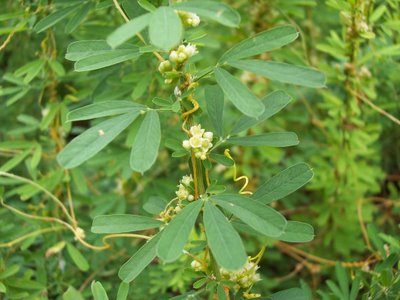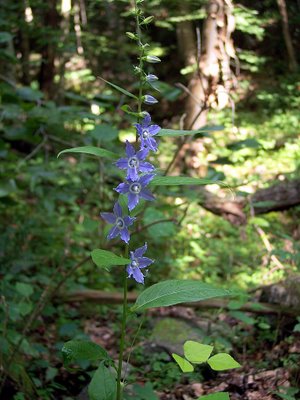 I just decided to take a picture in black and white one day...this one is a Tulip poplar (Liriodendron tulipifera.) I took this photo in the Talladega National Forest, near Heflin, AL.
I just decided to take a picture in black and white one day...this one is a Tulip poplar (Liriodendron tulipifera.) I took this photo in the Talladega National Forest, near Heflin, AL. 
Consider the lilies of the field how they grow: they toil not, nor spin; but I say to you that not even Solomon in all his glory was arrayed as one of these.
 Mimulus alatus (Winged Monkeyflower) is a member of the plant family Scrophulariaceae (the snapdragon family). This family is usually characterized by bilabiate flowers that can be opened like snapdragons. Winged monkeyflower typically grows in open, wet woods and produces many flowers along its stem from the leaf axils. It flowers in mid- to late July. This photograph was taken in Jackson Co., AL in a natural seep along an old logging road. This deer resistant plant is native to Alabama and is reputed to be a food source for Buckeye butterflies.
Mimulus alatus (Winged Monkeyflower) is a member of the plant family Scrophulariaceae (the snapdragon family). This family is usually characterized by bilabiate flowers that can be opened like snapdragons. Winged monkeyflower typically grows in open, wet woods and produces many flowers along its stem from the leaf axils. It flowers in mid- to late July. This photograph was taken in Jackson Co., AL in a natural seep along an old logging road. This deer resistant plant is native to Alabama and is reputed to be a food source for Buckeye butterflies. 
 Adiantum capillus-veneris (Venus' Hair Fern) is a fern that is commonly found on wet, rocky outcroppings near streams and rivers. This delicate fern is widespread around the world and is found in the US across the southern states from coast to coast. The fan shaped leaves hang from blackish-purple stems and closely resemble Maidenhair Fern (Adiantum pedatum) leaves. Adiantum capillus-veneris literally means the hair (capillus) of venus (veneris) that is unwettable (adiantum.)
Adiantum capillus-veneris (Venus' Hair Fern) is a fern that is commonly found on wet, rocky outcroppings near streams and rivers. This delicate fern is widespread around the world and is found in the US across the southern states from coast to coast. The fan shaped leaves hang from blackish-purple stems and closely resemble Maidenhair Fern (Adiantum pedatum) leaves. Adiantum capillus-veneris literally means the hair (capillus) of venus (veneris) that is unwettable (adiantum.) 
 Wood Sage (Teucrium canadense) is better known as American Germander. This member of the mint family (Lamiaceae) has a foul smelling leaf when crushed, but was still used by early settlers for a variety of ailments. The flower structure is unusual having three sepals that stand up on top of the flower.
Wood Sage (Teucrium canadense) is better known as American Germander. This member of the mint family (Lamiaceae) has a foul smelling leaf when crushed, but was still used by early settlers for a variety of ailments. The flower structure is unusual having three sepals that stand up on top of the flower. 

 Dodder (Cuscuta gronovii?) in flower and parasitizing Chinese Lespedeza (Lespedeza cuneata.) You can decide for yourself which of the two plants is more evil. Dodder is native, but a nasty parasite. Chinese Lespedeza is a vigorous ivasive, but nitrifies the soil and does a great deal to prevent erosion. Either way, I liked this picture and thought I'd share it.
Dodder (Cuscuta gronovii?) in flower and parasitizing Chinese Lespedeza (Lespedeza cuneata.) You can decide for yourself which of the two plants is more evil. Dodder is native, but a nasty parasite. Chinese Lespedeza is a vigorous ivasive, but nitrifies the soil and does a great deal to prevent erosion. Either way, I liked this picture and thought I'd share it. 
 Dense Blazing Star (Liatris spicata) is a perennial, herbaceous plant that can reach hieghts of up to 7 feet tall. The leaves are linear in shape and are largest at the base of the plant tapering towards the top. Found in thin to open woods, usually in a moist area, Dense Blazing Star will have lavender blooms from early summer through fall.
Dense Blazing Star (Liatris spicata) is a perennial, herbaceous plant that can reach hieghts of up to 7 feet tall. The leaves are linear in shape and are largest at the base of the plant tapering towards the top. Found in thin to open woods, usually in a moist area, Dense Blazing Star will have lavender blooms from early summer through fall. 


 Tall Bellflower (Campanula americana) is blooming now in North Alabama. This picture was taken near Hytop, AL. It was growing in a wet area with mature trees shading it, but can also be found in open woods, thickets, and woodland borders. The star-shaped flowers grow on long branching spikes that can reach 6 feet tall. The blue flower has a distinctive long, curving style at its center and will bloom for over two weeks.
Tall Bellflower (Campanula americana) is blooming now in North Alabama. This picture was taken near Hytop, AL. It was growing in a wet area with mature trees shading it, but can also be found in open woods, thickets, and woodland borders. The star-shaped flowers grow on long branching spikes that can reach 6 feet tall. The blue flower has a distinctive long, curving style at its center and will bloom for over two weeks. 